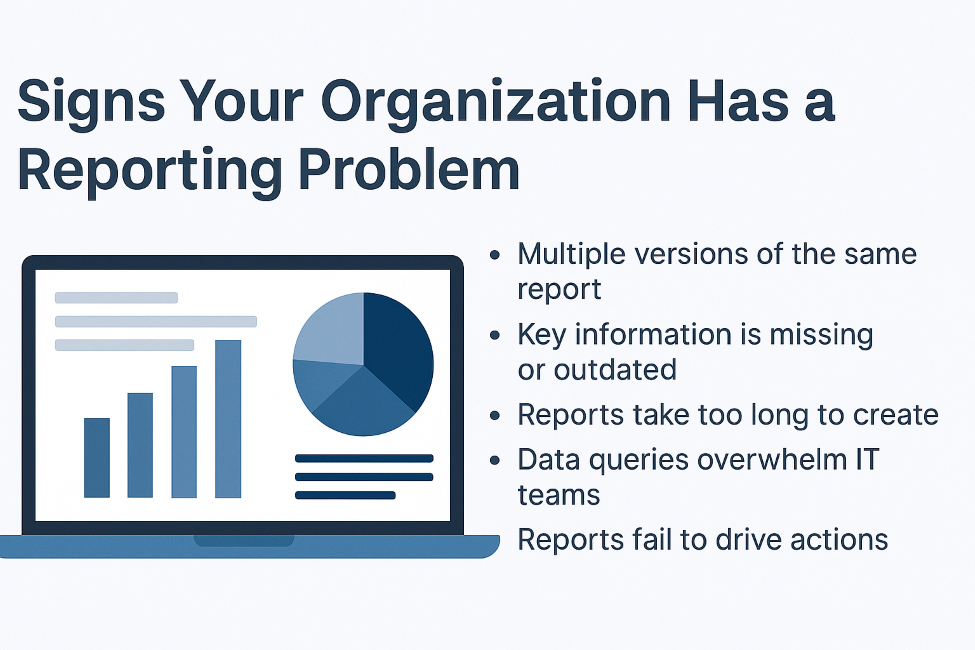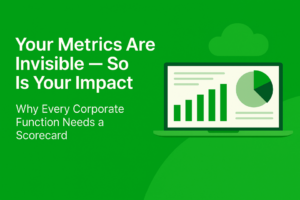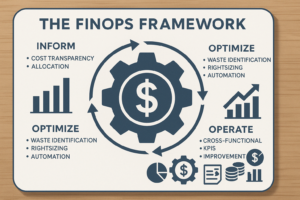In today’s data-driven world, businesses are generating more information than ever. But despite all the dashboards, KPIs, and analytics tools, many leaders still operate in the dark. Reporting is supposed to drive insight—but too often, it just creates more questions, confusion, or delays. If your reporting feels more like a bottleneck than a benefit, you might be dealing with deeper issues than you think.
Here are some unmistakable signs your organization has a reporting problem—and what you can do about it.
🚩 1. Reports Take Too Long to Produce
Your reporting cycle is likely built on manual data pulls, cross-functional email chains, and spreadsheet stitching. Analysts are bogged down with recurring requests, while leaders are stuck waiting on numbers.
Organizations that break free from manual reporting start by investing in automated data pipelines and centralized data models. Once reports are fed by trusted, real-time data sources, business users can self-serve insights without waiting days for an analyst. After this foundation is in place can you start layering in AI-powered alerting and anomaly detection, allowing the business to move from reactive reporting to proactive decision-making.
➡️ Fix your data flows. Streamline your dashboards. Then amplify decisions with automation.
👉 Build the reporting backbone your AI strategy needs.
🚩 2. Everyone Has a Different Number
Without centralized definitions or governed KPIs, each team interprets metrics differently. Finance says one thing, Sales says another, and IT builds its own version in isolation.
When every team defines “revenue” or “margin” differently, trust breaks down. High-performing organizations start by aligning teams around a semantic data layer—a single source of truth for all KPIs. They define metrics once and use them everywhere. With that consistency in place, AI models can confidently analyze patterns across departments—forecasting trends and surfacing exceptions, without human recalibration.
➡️ Before AI can explain your numbers, your teams need to agree on them.
👉 Standardize your data definitions and prepare your KPIs for intelligent insights.
🚩 3. You’re Drowning in Reports, But Starving for Insight
You have too many dashboards—often created in silos, without purpose. No one knows which ones to trust, which are outdated, and which actually support decision-making.
More dashboards aren’t the answer—better governance and purposeful design are. Organizations must start by decluttering their reporting landscape, retiring outdated dashboards, and cataloging what’s important. Once this is done, you can introduce AI agents to surface relevant insights, summarize trends across dashboards, or recommend new metrics based on usage patterns.
➡️ Clean your BI house before inviting AI in.
👉 Curate your dashboard portfolio and prepare for smart analytics.
🚩 4. Leadership Still Uses Excel
Executives default to Excel because dashboards don’t show what they want—no context, no trends, and no narrative. BI tools feel like data dumps, not decision tools.
If your dashboards don’t reflect how leaders think, they’ll return to Excel. The first step is to redesign dashboards that mirror decision workflows—not just present data. These should offer context, comparisons, and confidence. Once adoption grows, organizations can embed natural language insights, AI-generated summaries, and scenario modeling to enhance leadership decisions in real time.
➡️ Executive dashboards don’t just need data—they need design and intelligence.
👉 Build the dashboards that drive leadership adoption.
🚩 5. No Cross-Functional Visibility
Your data lives in silos: HR has its system, Finance another, Ops a third. Without integration, there’s no unified view—and no accountability across functions.
Disconnected teams can’t make coordinated decisions. Begin by integrating your data sources into a unified data platform—whether it’s a Lakehouse, Microsoft Fabric, or an AWS-native stack. With shared, governed data can you introduce cross-functional analytics—and eventually, AI-driven decision support that surfaces business-wide insights no silo could spot on its own.
➡️ AI thrives on integrated data—but first, your platform must evolve.
👉 Connect your systems and build a foundation for AI-powered visibility.
📈 Final Thoughts
Dashboards that don’t guide decisions are just digital wallpaper.
And if your competitors are making faster, smarter decisions using AI-infused insights—they’re gaining an edge you can’t afford to ignore.
At ClarityWork, we specialize in transforming outdated reporting ecosystems into modern decision intelligence platforms—powered by BI, AI, and business-aligned KPIs.
📍 Want to know where your reporting stands?
👉 Schedule a free BI Maturity Assessment call





